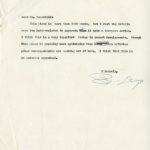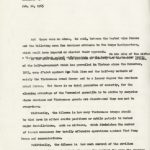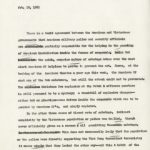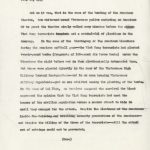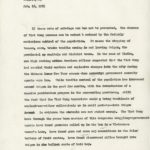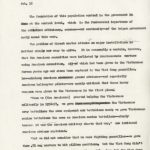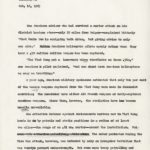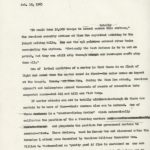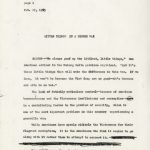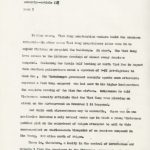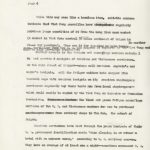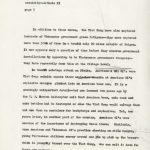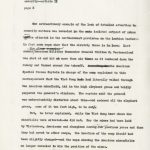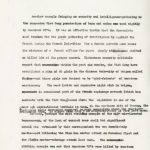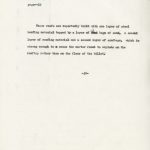1965, February 16, “American Billets and Vietnamese Airbases”
Dear Mr. Rosenfeld:
This piece is more than 2000 words, but I felt the details were too inter-related to separate them into a two-part series. I think this is a very important factor in recent developments, though this piece is probably more optimistic than other pices articles other correspondents are sending out of here, I think that this is an accurate appraisal.
Sincerely,
Bev Deepe
deepe
security–1 — Article I.
feb. 16, 1965
SAIGON–The defenses around American billets and Vietnamese airbases are not good enough–butyet there is no total defense against bold Viet Cong attacks a nd acts of sabatoge .
In the recent Pleiku attack on Februrary 7th in which eight Americans were killed and 108 wounded in worst battle incident of the war, there were barbed wire fences around the perimeter–butyet unlike even the most isolated Vietnamese outpost there were no beer cans with pebbles-filled beer cans to make a noiserattlewhen touched–and Viet Cong squads took one-half hour without detection to cut a hole in the doubled- double rows of wire.
According to American military spokesman there were trip flares along the fence, but “none of these were activated.” There were eight German shepherd scout dogs in the Pleiku area, but none|of these were assigned to the protection of the base. There were also, he said, flood lights along the barbed wire fence, but none of them were strong enough to see the intruding VietCong, dressed in black pajamas. like as black as the night.
deepe
security–2 — Article I.
feb. 16, 1965
And there were no mines, he said, between the barbed wire fences and the billeting area for American advisors to Two Corps headquarters, which would have impeded or alerted their approach. On one side of the airbase a Vietnamese ambush patrol withdrew into statio bunkers only one hour beofra attack.
In the last analysis, the problems of security are the result of the half-government which has prevailed in Vietnam since the November, 1963 coup d’etat against Ngo Dinh Diem and the half-way methods of mainly the Vietnamese armed forces and to a lesser degree the American armed forces. Yet there is no total guarantee of security, for the alarming advantage of the Communist guerrilla is to strike by surprise where American and Vietnamese guards are absent–and they can not be everywhere.
Militarily, the dilemma is how many Vietnamese troops should be tied down in either static positions or mobile patrols to defend major installations, such as airbases, which diminishes the number of troops necessary for totally offensive operations against Viet Cong bases and concentrations.
Politically, the dilemma is how much control of the civilian population should be maintained–the more the control the more the chances of alienating them to the extend of openly or secretly opposing the government. But population control in the provinces is ineffective without a stable efficient government in Saigon–which is still the major problem of the country.
deepe
security–3 — Article I.
feb. 16, 1965
In the six Viet Cong anti-American attacks and acts of sabatoge within the past year, there are three pertinent points:
1. While the major a these these six major attacks grabbed world-wide headlines–and two of them touched off retaliatory bombing raids on North Viet Nam–the Viet Cong launch these attacks in miniature every night of the year against isolated outposts and villages throughout the country.
2. While these six attacks appear disasterous in newspaper accounts, American advisors who have been hit feel they were relatively lucky. In the mortaring of Pleiku, for example, 21 of the 54 mortar shells fell short of their targets and did no damage and one heroic and alert American guard prematurely triggered the suicide squads. In the mortaring of Bien Hoa airbase on November 1 last year, American pilots and advisors felt they came off lucky–with only four killed and 72 wounded.
3. While American policymakers retaliated against by Aerial bombing North Viet Nam for two of the recent attacks, they rejected for unknown reasons the to send American defensive, ground combat teams to defend these bases within South Vietnam. While there has been an increase of American security personnel, iin December, 1963, one American military police company werewas among the 1000 military which were withdrawn December, 1963–[Randomly?]. Three months later, the Viet Cong began their acts ofAnti-American sabatoage . against Americans.
deepe
security–4
feb. 16, 19631965
The six Viet Cong american attacks anti-American attacks and acts of sabotage within the past year accounted for at least thirty one killed (nine in the Qui Nhon billet rubble still are unaccounted for) a nd 336 wounded. These six incidents fall into three separate categories–with different por problems and diffi different attempted solutions–direct mortar attack, ant acts of sabatoge and a combination of both.
The acts of sabatoge were last year the blowing up of American bleachers during softball game (2 killed; 23 wounded on February 9); the exploi blowing up of American theatre (3 killed and 49 wounded on February 16) and the blowing up of American officers quarters on Christmas eve (2 killed and 62 wounded) and recently this year the bombpm exploding of the Qui Nhon m enlisted men’s villa in which 12 were killed, 22 wounded and nine still unaccounted for in the mass of rubble.
The attack on the Bien Hoa airbase on November 1 is an example of direct mortar attack (4 killed and 72 wounded plus destroying virtually full squadron of American B-57 jet-fighters); the Pleiku attack is a n exm example of combined mortar attack plus acts of sabatoge .
(More)
deepe
security –5
feb. 16, 1965
There is a tacit agreement between the American and Vietnamese governments that American military police and security officials are responsible partially responsible for the helping in the guarding of American installations inside the fences compounds,. but But because of the quick, surprise nature of sabatoge makes even the most alert American MP helpless to preven th prevent the attack. Hence, at the bombing of the American theatre a year ago this week, the American MP shot one of the two sabateurs , but still the attack could not be prevented. The explosion Christmas Eve explosion at the Brink i officers quarters is still presumed to be a mystery; a truckfull of explosive charges–either tnt or plastique–was driven inside the compoundx which was to be guarded by American MP’s, and simply exploded.
In the other three cases of direct acts of sabatoge , indirect complicity by the Vietnamese population or police was implied, though never officially given as a reason f all permitting theact sabatoge . In the midst of the exploti This does not necessarily imply that the population or the police were directly supporting the Viet Cong terroriest terrorists; it means simply that they looked the other way–and this t habit of the Vietnamese has existed during the French Indo-China War. A classic cl case then was when the French security chief was assassinated coming out of his office on the main street of Saigon–and two Vietnamese police simply walked by away.
deepe
security–6
feb. 16, 1965
And so it was, that in the case of the bombing of the American theatre, two white-uniformed Vietnamese police assisting an American MP to guard the theatre simply walked away minutes before the attacx Viet Cong terrorists incited set a satchel-ful of plastique in the doorway. In the case of the blowing-up of the American bleachers during the during the American softball game–the Viet Cong terrorists had planted twenty-pound bombs (fragments of 100-pound Air Force bombs) under the bleachers the night before and is then electronically detonated them. But these were planted directly in the rear of the Vietnamese High Military Command Headquarters–and in an area housing Vietnamese military dependents–yet no one admitted seeing the planting of the bombs. In the case of Qui Nhon, an American sergeant who survived the blast expressed the opinion that the Viet Cong terrorists had used the houses of the civilian population across a narrow street to hide in until they emerged for the attack. Despite the alertness of the Americans inside the building and[ ?] bristling security precautions of the Americans–still the attack act of sabatoge could not be prevented.
(More)
deepe
security–7
feb. 16, 1965
[Therefore?] If these acts of sabatoge can box not be prevented, the chances of Viet Cong success can be reduced b reduced by the fetishly meticulous control of the population. It means the stopping of busses , cars, trucks traffic coming in and leaving Saigon, the provincial cp capitals and district towns. In the case of Pleiku, one high ranking office American officer suspected that the Viet Cong had carried their mortars and explosive charges into the city during the Chinese lunar New Year season when sesurity government security agents were lax. While traffic control of the population has increased around Saigon in the past few months, with the introduction of a massive pacification program in the surrounding provinces, still the fact that the Viet Cong terrorists could g bring truckloads of explosives–either collectively or in small packets–into Saigon ismact is evidence the controls are not strict enough. The Viet Cong have through the years been masters of this dangerous smuggling–government agents have found grenades rolled up in the bun in v Vietnamese women’s hair, have found guns and annu amj ammunitions in the false bottoms of fruit crates, have found discovered rifles brought into Saigon in the bullock carts of the hair hay.
deepe
security–8
feb. 16
The foundation of this population control is the government in the at the central level, which is the fundamental importance of the efficient efficiency–and continuity–of the Saigon government newly named this week.
The problem of direct mortar attacks on major installations also is neither simple nor easy to solve. It is reasonably s certain, however, that the American casualties were inflicted by American-made mortars using American ammunition, all of which had been given to the Vietnamese forces years ago and since been captured by the Viet Cong guerrillas. Low-echelong American advisorsm ground advisors–and especially American helicopter pilots–are openly critical that these heavy weapons were given to the Vietnamese in the first place.
“When we (the Americans) started helping the Vietnamese militarily in 1956-57, we gave them many things and the Vietnamese army battalions the same equipment our battalions used; we gave Vietnamese marine battalions the same as American marine battalions–simply because it was [on?] the American military charts that way,” one irritated American advisor explained.
“But we did not consider that we were fighting guerrillas–we gave them .81 mm. mortars to hit pillbox positions, but the Viet Cong didn’t use pillboxes; we gave them .57 recoiless rifles (as but the Viet Cong didn’t have tanks; we gave them .50 calibres machineguns for large troop concentrations, but the Viet Cong then were in small bands. Now they are using all of that to fight us.”
deepe
security–9
feb. 16
One American advisor who had survived a mortar attack on his district headqua rters –only 20 miles from Saigon–complained bitterly “that Uncle Sam is equipping both sides, but giving advice to only one side.” Helico American helicopter pilots openly cringe when they hear a .50 calbire calibre weapon has been captured.
“The Viet Cong put a home-made viewp viewfinder on those .50s,” one American l pilot explained, “and can shoot down American helicopters as easy as breathing.”
A year ago, American military spokesman estimated that only two per cent of the weaspo weapons captured from the Viet Cong were made in Communist countries; the remainder were either old French weapons or newly captured American weapons. Since then, however, the statistics have hae become unavila unavailable.
One effective defense against Amrican -made mortars now in Viet Cong hands is is by patrols and static positions in a radius of at least two miles–the range of an .81 mm. mortar–around the installation. But even with efective patrolling this xlacm The outer perimeter during the Bien Hoa attack, however, was defended by only an irregular battalion that was twentyx percent understrength. But even more troop patrolling and securing of the outer perimeter is limited by the numberxx jungled mountain terrain and the number of troops that can be tied down for airbase security.
deepe
security–10
feb. 16
“It would take 10,000 troops to securi secure totally this airbase,” the American security advisor at Bien Hoa explained pointing to the junged rolling hills, the and the apl palmtree covered river banks surrounding the airbase. “Obviously the best defense is to be out on patrol, but they can still slip through carry our rear–you can’t stop them all.”
One of the lethal qualities of a mortar is that there is no flash of light or sound when the mortar round is fired–the noise comes on impact at the target. Hence, at Bien Hoa, during the Bien Hoa attack, American aircraft and helicopters poured thousands of rounds of ammunition into suspected areas–but did not kill one Viet Cong.
If mortar attacks can not be totally eliminated–though it there are certain to be more of them–their success also can be reduced. One of these devicexm is a “counter-firing device” which automatically calibrates the position of the a ttacking mortars aimed at the tematmally search thempmm and pinpoints the position for government mortars to counter-attack. These devices, used in Korean War and discussed after the November 1 attack were described by American Military Commander Gen. William C. Westmoreland and “pretty good if fire is sustained so one can get the data,” but he said were “still being tested.” They have to get to be shipped to Viet Nam.
#
Part Two
Little Things in a Bigger War
deepe
security–article II–
page 1
feb. 17, 19765
LITTLE THINGS IN A BIGGER WAR
SAIGON–“We always goof up the littlest, little things,” one American advisor in the Mekong delta province explained. “And it’s these little things that will make the difference in this war. If we lose, it won’t be because the Viet Cong are so good–it’s because out side is so bad.”
The lack of fetishly meticulous control–because of American bureauracracy and the Vietnamese inefficiency and corruption–that is a contributing factor to the problem of security, which is one of the most important problems in this country experiencing a guerrilla war.
While Americans here openly ridicule the Vietnamese for their flagrant corruption, it is the Americans who find it easier to go along with it rather than attempt to correct it. In some cases, the Americans–civilian and military–are part of the game.
For exa mpe example, foreign economic experts are openly shocked at the indirect way in which U. S. military and economic funds and goods contribute to the Viet Cong Communist guerrilla strength.
deepe
security–article II–
page 2
“All the aircraft gasoline fortrucked to the big American helic opter base at Soo Trang is taxed twice by Viet Cong roadblocks,” he explained. “Then it is piped into American helicopters to kill Viet Cong. It does not make sense. It might have been excused in 195 1962 at the beginning of American involvement, but in 1965 it is a sign of weakness.”
Sootrang, 100 miles southwest of Saigon, has been mortared at least three times by the Viet Cong, including once immediately following the recent bombing raids on North Viet Nam. The aircraft fuel is purchased from petroleum companies which sublet the trucking of the gasoline to Vietnamese contracting companies, which in turn pay off the Viet Cong to get through their roadblocks, according to petroleum company officials.
In another case, American military officials contracted to Vietnamese construction companies the building of American bui billets and compounds in the provinces, especially in 1962-63. But in order to cut the trees for lumber, these Vietnamese contracting firms paid Viet Cong taxes–and this cost was jx hiked onto the price ofPaid By the U. S. government. Indirectly, Amerix the U. S. government paid taxes to the Viet Cong.
deepe
security–article III—
page 3
In many cases, Viet Cong construction workers built the American compounds–in other cases Viet Cong sympathizers later came in to repair fixtures or re-paint the buildings. In short, the Viet Cong have access to the interior drawings [ ?] of almost every American compound. Following the Tonkin Gulf bombing of North Viet Nam in August when American policymakers moved a squadron of B-57 jet-fighters to Bien Hoa , the Viet Cong government security agents soon afterwards captured a Viet Cong sergeant who had sent to his higher headquarters the complete drawing of the Bien Hoa airbase. Only noon He told Vietnamese officials that the Viet Cong were planning an attack on the airbase–and on November 1 it happened.
But while such circumstances may be excusable, there was in one particular instance a only several weeks ago in which a young Vietnamese peddlar girl on the mainstreet of Saigon attempted to sell to this correspondent an American-made blueprint of an American compound in Nha Trang, 200 miles north of Saigon.
There is, therefore, a laxity in the control of informationplans and materia l from the Americans to the Vietnamese government authorities, which allows the Viet Cong to buy on the open market whatever they need. One a Another example, is that under the U. S. economic aid program quantities of suntan lotion have been sent ot to South Viet Nam.
deepe
security–article II–
page 4
While this may seem like a harmless item, reliable sources indicate that Viet Cong guerrillas have stockpiled regularly purchase large quantities of it from the Long Dien open market (a market in Viet Cong control 30 miles southeast of Saigon in Phuoc Tuy province). They use it for treating napalm burns. In another case, fertilizer from the U. S. aid program is captured by the Viet Cong and used to make low-order explosives.
Another example is the fatigue and camouflage uniform materia l fo and service i insignia of American and Vietnamese servicemen. On the main street of Catinat–shops sell American captain’s and major’s insignia, sell the fatigue uniform hats shapped like baseball caps with American insignia on it; American shopkeepers servicemen regularly buy their boots onx from local shopkeepers–which could easily be copied by the Viet Cong or Eurasian or Caucasian Communists. Vietname Marine the black and green fatigue camouflage uniforms of the U. S. and Vietnamese marines isx can be purchased on the open markemm from ordinary shops in Thu Duc, the suburb of Saigon.
American servicemen have lost through the years hundreds of their U. S. government identification cards “when sleeping in an unknow n hotel with an unknown woman,” according to U. S. military sources. They lose an average of at least one a night–sometimes more–and U. S. authorities are hoping they are not used bx sent to Europe to infiltrate onto American bases there. In short, the Viet Cong have all the means available to them on the open market to outfit themselves exactly like a Vietnamese government or a Vm American soldier.
deepe
security–article II–
page 5
In addition to these means, the Viet Cong have also captured hundreds of Vietnamese government green fatigues–they once captured more than 5000 of them in a truckl only 20 miles outside of Saigon. It now appears only a question of time before they overrun the government installations by appearing to be Vietnamese government troopers–they have repeatedly done this at the village level.
In the Pl sabatoge attack on Pleiku, American x GII GI’s were Viet Cong suicide squads threw explosive charges at American GI’s explosive charges plunked into an American beer cans. It is a seemingly unimportant detail–but one learned two years ago by the U. S. Marine helicopter unit that American beer, soda cans and coke bottles had be destroyed or else the Viet Cong would salvage them and use them as container for boobytraps and explosives. Yet, two years later, in another part of the country, American GI’s were unaware of the importance of destroying these items. Similarly, when American and Vietnamese GI’s practice shooting on rifle rangesempty [garbage?], young Vietnamese children scurry around and pic up pick up the brass–which is promptly turned over to the Viet Cong, who can melt it down for their own purposes.
deepe
security–article II–
page 6
One extraordinary example of the lack of detailed attention to security matters was revealed in the out isolated outpost of Ashau siaute situated in the northernmost provinces on the Laotian border–in fact some maps show that the airstrip there is in Laos. Last summer the plane carrying American Military Commander General William C. Westmoreland was shot at and hit ab more than six times as it lumbered down the runway and turned around for takeoff. According tothe American Special Forces Captain in charge of the camp explained to this correspondent that the Viet Cong had had literally walked through the American minefield, hid in the high elephant grass and boldly peppered the general’s airplane. The captain said the general was understandably disturbed about this–and ordered all the elephant grass, some of it ten feet high, to be cut..
But, he later explained, while the Viet Cong knew where his minefields were situated–he did not. For the mines had been laid by Vietnamese, Americans and aborgines during the two previous years and then they had moved to other camps, the location of the camp itself had been slightly changed–and the maps showing the American minesfields no longer revealed to him the position of the mines.
Finally, an American mining expert in mines was flown out from the corps headquarters–to determine the location of the Government mines–and then days were spent d cutting the grass elephant grass.
deepe
security–7 article II
page–7
It is also often heard in Viet Nam that one of the key problems of i security and of winning the war is that of intelligence–who are the Viet Cong, where are they concentrated and what are they doing. It is openly acknowledted by mi Vietnamese military officials that the Viet Cong have agents at in the highest level of the Vietnamese military, inthe police and the government some levels of the police and the government. Some Vietnamese security officials also believe that they have penetrated into the American military command headquarters. Their argument is that the Vietnamese working in the American command–Vietnamese secretaries, office boys and janitors–have been cleared by Vietnamese pero personnel and security forces whio give the proper jobs and security clearnac clearances on the basis of money[payoffs?]–and not on the basis of anti-Communist political leanings. For the price of four months salary, these security officials maintain, any Vietnamese can get an a job in the American command (the price has risen, however–once the price was a months salary). Hence when the explosives last month blew up one passageway in theone American headquarters building, Vietnamese security officials had little sympathy for the plight of the American staff officers inside.
deepe
security–8
Another example fringing on security and intelligence-gathering is the suspected Viet Cong penetration of bars and cafes use used nightly by American GI’s. It was an effective tactic that the Communists used in the for the gater gathering of intelligence by against the French during the French Indo-China War a decade ago–in some cases the mistress of a French officer for years simply killed or stabbed or killed him at the proper moment. Vietnamese security officials report that suspectibly within the past six months, the Viet Cong have established a ring of 40 girls in the Chinese twin-city of Saigon called Cholon–and these girls are trained to be “girl-friends” of American servicemen. The most lavish and expensive night club in Saigon, cponsiedm is considered part of the French espionage network (which has contacts with the Viet Cong)–and above the nightclub is one of the most sph sophisticated brothels in town. In the northern city of Danang, the Vietnamese corps commander received so many complaints about the American-frequented bars, he closed nine down 9 on mainstreet–but 33 were left open.
However, perhaps the most striking example of the mid- mis-directed bureaucracy, of the lack of control over small but significant detail was witnessed by this correspondent who was immediately on-the-spot following the Bien Hoa mortar attack on November first and the Pleiku mortar-sabatoge attack last week. The example striking example was not that American GI’s were killed by American ammunition and suspected American mortars–or that Vietnamese sentries had not been patrolling actively enough. It was the fact that a Viet Cong mortar attack could have been rendered less lethal by [the contribution of?] a more practical and substantial roof on American billets.
deepe
security–Article II
security–9
In early 1962, American engineers drafted the construction of th for use throughout the country of low-slung motel-like buildings for American advisory teams and helicopter and aircraft crews. All of these had frail roofs made of an half-inch thick asbestos material which has both the appearance and consistency of papier-mache.
In both the Bien Hoa and the Pleiku mortar attacks, the mortar rounds–because of their high trajectory–plunked directly through the insubstantial roofs and exploded on impact with the floor. Some of the first rounds–through fragmentation or concussion–killed or wounded American GI’s before they ever got out of bed.
These frail roofs–with a shallow slope–are in contrast both to these used by French a decade ago and those currently being constructed by the British and Malaysians in the wilds of Boreno. During the French Indo-China War, the roofs of French billets in general were made of steel–which caused the mortars to explode on impact with the roof instead of the floor–and were of a very steep slope, like that of St. Patricks Cathedral in New York. This steep slope caused many of the mortar rounds to slide down to the ground and explode outside the billet.
The British in Boreno are also reportedly building meticulously elaborate roofs on their jungle camps in the along the Boreno-Indonesian border.
deepe
security–ARTICLE II
page–10
These roofs are reportedly built with one layer of steel roofing material topped by a layer of sand bags of sand, a second layer of roofing material and a second layer of sandbags, which is strong enough to c cause the mortar round to explode on the rooftop rather than on the floor of the billet.
-30-
Read Previous Article: 1965, February 13, “Strong Stable Government”
Read Next Article: 1965, February 18, “Distinct Military Wars”

